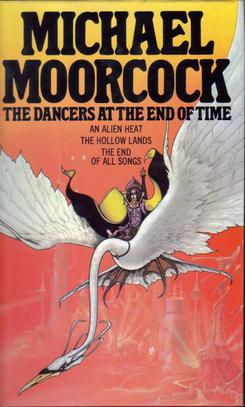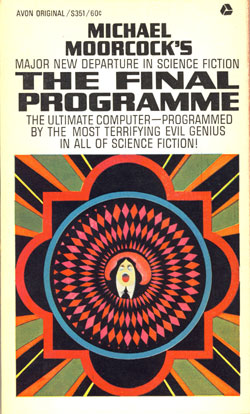
Michael John Moorcock is an English–American writer, particularly of science fiction and fantasy, who has published a number of well-received literary novels as well as comic thrillers, graphic novels and non-fiction. He has worked as an editor and is also a successful musician. He is best known for his novels about the character Elric of Melniboné, which were a seminal influence on the field of fantasy in the 1960s and 1970s.

The Time Machine is a post-apocalyptic science fiction novella by H. G. Wells, published in 1895. The work is generally credited with the popularization of the concept of time travel by using a vehicle or device to travel purposely and selectively forward or backward through time. The term "time machine", coined by Wells, is now almost universally used to refer to such a vehicle or device.

The Moon Is a Harsh Mistress is a 1966 science fiction novel by American writer Robert A. Heinlein about a lunar colony's revolt against absentee rule from Earth. The novel illustrates and discusses libertarian ideals. It is respected for its credible presentation of a comprehensively imagined future human society on both the Earth and the Moon.
Jerry Cornelius is a fictional character created by English author Michael Moorcock. The character is an urban adventurer and an incarnation of the author's Eternal Champion concept. Cornelius is a hipster of ambiguous and occasionally polymorphous gender. Many of the same characters feature in each of several Cornelius books, though the individual books have little connection with one another, having a more metafictional than causal relationship. The first Jerry Cornelius book, The Final Programme, was made into a 1973 film starring Jon Finch and Jenny Runacre. Notting Hill in London features prominently in the stories.
The Eternal Champion is a fictional character created by British author Michael Moorcock and is a recurrent feature in many of his speculative fiction works.

The Stars My Destination is a science fiction novel by American writer Alfred Bester. Its first publication was in book form in June 1956 in the United Kingdom, where it was titled Tiger! Tiger!, named after William Blake's 1794 poem "The Tyger", the first verse of which is printed as the first page of the novel. The book remains widely known under that title in the markets in which this edition was circulated. It was subsequently serialized in the American Galaxy Science Fiction magazine in four parts, beginning in October 1956. A working title was Hell's My Destination; the book was also associated with the name The Burning Spear. It would prove to be Bester's last novel for 19 years.
The Frankenstein complex is a term coined by Isaac Asimov in his robot series, referring to the fear of mechanical men.

The Dancers at the End of Time is a series of science fiction novels and short stories written by Michael Moorcock, the setting of which is the End of Time, an era "where entropy is king and the universe has begun collapsing upon itself". The inhabitants of this era are immortal decadents, who create flights of fancy via the use of power rings that draw on energy devised and stored by their ancestors millions of years prior. Time travel is possible, and throughout the series various points in time are visited and revisited. Space travellers are also common, but most residents of the End of Time find leaving the planet distasteful and clichéd. The title of the series is itself taken from a poem by a fictitious 19th-century poet, Ernest Wheldrake, which Mrs. Amelia Underwood quotes in The End of All Songs. "Ernest Wheldrake" had been a pseudonym used by Algernon Charles Swinburne.

Veniss Underground is a 2003 fantasy novel by American writer Jeff VanderMeer, following the adult lives of three different protagonists across a short period of time in the decadent, surreal city of Veniss, which is situated above a vast underground labyrinth of hovels and mines ruled over by the amoral crime lord Quin.

The Black Corridor is a science fiction novel by Michael Moorcock. It was published in 1969, first by Ace Books in the US, as part of their Ace Science Fiction Specials series, and later by Mayflower Books in the UK.

The Warlord of the Air is a 1971 British alternate history novel written by Michael Moorcock. It concerns the adventures of Oswald Bastable, an Edwardian era soldier stationed in India, and his adventures in an alternate universe, in his own future, wherein the First World War never happened. It is the first part of Moorcock's A Nomad of the Time Streams trilogy and, in its use of speculative technology juxtaposed against an Edwardian setting, it is widely considered to be one of the first steampunk novels. The novel was first published by Ace Books as part of their Ace Science Fiction Specials series.
A shaggy God story is a story in a minor science fiction genre that attempts to explain Biblical concepts with science fiction tropes. The term was coined by writer and critic Brian W. Aldiss in a pseudonymous column in the October 1965 issue of New Worlds. The term is a pun on the phrase shaggy dog story.

The Chinese Agent (1970) is a comic novel by Michael Moorcock. It is a revision of Somewhere in the Night, which Moorcock published in 1966 under the pseudonym Bill Barclay. Although Moorcock is best known as the author of fantasy fiction and science fiction-based parables such as Behold the Man and The Dancers at the End of Time, here he writes a light-hearted caper that parodies the spy novel genre.
Michael Butterworth is a British author, publisher and campaigner who first became known publicly as an author of New Wave science fiction. He later founded the publishing house Savoy Books with David Britton in 1976 and the contemporary art journal Corridor8 with Sarajane Inkster in 2009. He successfully fought a charge of obscenity against Britton's controversial novel Lord Horror during 1992, the first novel to be banned in England since Hubert Selby Jr.'s Last Exit to Brooklyn in 1967.

A Nomad of the Time Streams is a compilation volume of Michael Moorcock's early steampunk trilogy, begun in 1971 with The Warlord of the Air and continued by its 1974 and 1981 sequels, The Land Leviathan and The Steel Tsar. The trilogy follows the adventures of Edwardian-era British Army Captain Oswald Bastable in alternate versions of the 20th century.

The Final Programme is a novel by British science fiction and fantasy writer Michael Moorcock. Written in 1965 as the underground culture was beginning to emerge, it was not published for several years. Moorcock has stated that publishers at the time considered it was "too freaky".
Barrington J. Bayley was an English science fiction writer.
This is a bibliography of the works of Michael Moorcock.
Modern Fantasy: The 100 Best Novels, An English-Language Selection, 1946–1987 is a nonfiction book written by David Pringle, published by Grafton Books in 1988 in the United Kingdom and the following year by Peter Bedrick Books in the United States. The foreword is by Brian W. Aldiss.
The multiverse is a series of parallel universes in many of the science fiction and fantasy novels and short stories written by Michael Moorcock. Central to these works is the concept of an Eternal Champion who has potentially multiple identities across multiple dimensions. The multiverse contains a legion of different versions of Earth in various times, histories, and occasionally, sizes. One example is the world in which his Elric Saga takes place. The multiplicity of places in this collection of universes include London, Melniboné, Tanelorn, the Young Kingdoms, and the Realm of Dreams.











